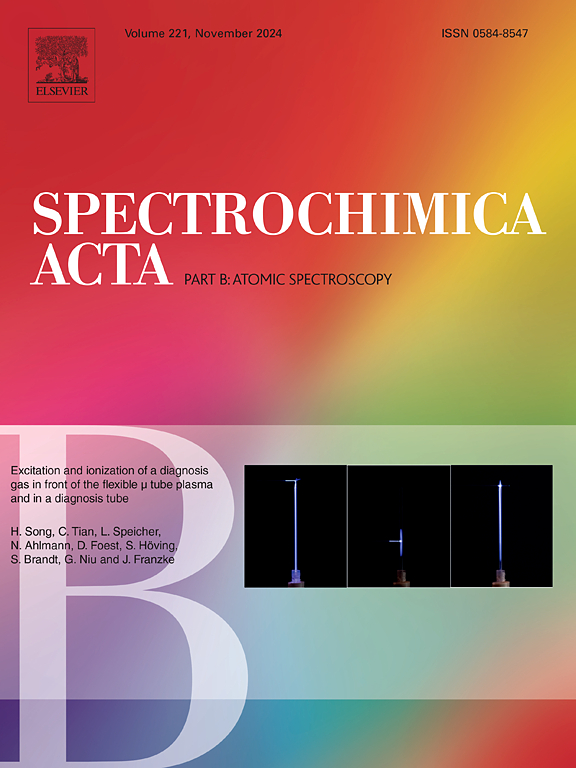Heavy metal galvanic displacement reaction on micrometer particles to assist LIBS for cu and Cr in liquids analysis with sub μg/L sensitivity
IF 3.2
2区 化学
Q1 SPECTROSCOPY
引用次数: 0
Abstract
Due to the severe threat posed by heavy metals to human health, relevant authoritative standards impose strict limits on the concentration of metal elements in water bodies, with the allowed minimum concentration of these elements reaching the μg/L level. Therefore, there is an urgent need to develop detection technologies for rapid, multi-element qualitative and quantitative analysis of heavy metal elements in water bodies at the μg/L level, especially in fields such as water quality monitoring or discharge control. This paper proposes a novel approach that combines a micron-sized particle galvanic displacement reaction with Laser-Induced Breakdown Spectroscopy analysis, referred to as the GDMP-LIBS method. This method can quickly complete the preparation of the micro-particle layer and the displacement reaction of heavy metal elements. By using the developed experimental procedure and optimized experimental parameters, the spectral signals obtained by this method show significant enhancement. For the detection of Cu and Cr, the detection limits are below 1 μg/L, with sensitivity greater than other LIBS methods, and the limits of detection (LoDs) are reduced by several orders of magnitude, even lower than the lowest allowed concentration in relevant authoritative water quality standards by at least one order of magnitude. In the low concentration range from a few μg/L to several tens of μg/L, the quantitative analysis error of this method is small. Overall, as a highly sensitive, rapid, multi-element, and easy-to-operate method for detecting heavy metals in water, the GDMP-LIBS method has the potential for widespread application in the field of heavy metal water quality detection.

微米颗粒上的重金属电位移反应辅助LIBS对液体中cu和Cr的亚μg/L灵敏度分析
由于重金属对人体健康的严重威胁,相关权威标准对水体中金属元素的浓度进行了严格的限制,允许的最低浓度达到μg/L。因此,迫切需要发展对水体中重金属元素进行快速、多元素定性和定量分析的检测技术,特别是在水质监测或排放控制等领域。本文提出了一种将微米级颗粒电位移反应与激光诱导击穿光谱分析相结合的新方法,称为GDMP-LIBS方法。该方法可以快速完成微颗粒层的制备和重金属元素的置换反应。采用改进的实验步骤和优化的实验参数,得到的光谱信号有明显的增强。对于Cu和Cr的检测,检出限均在1 μg/L以下,灵敏度高于其他LIBS方法,检出限(lod)降低了几个数量级,甚至低于相关权威水质标准的最低允许浓度至少一个数量级。在几μg/L到几十μg/L的低浓度范围内,该方法的定量分析误差很小。总体而言,GDMP-LIBS法作为一种灵敏度高、快速、多元素、操作简便的水中重金属检测方法,在重金属水质检测领域具有广泛应用潜力。
本文章由计算机程序翻译,如有差异,请以英文原文为准。
求助全文
约1分钟内获得全文
求助全文
来源期刊
CiteScore
6.10
自引率
12.10%
发文量
173
审稿时长
81 days
期刊介绍:
Spectrochimica Acta Part B: Atomic Spectroscopy, is intended for the rapid publication of both original work and reviews in the following fields:
Atomic Emission (AES), Atomic Absorption (AAS) and Atomic Fluorescence (AFS) spectroscopy;
Mass Spectrometry (MS) for inorganic analysis covering Spark Source (SS-MS), Inductively Coupled Plasma (ICP-MS), Glow Discharge (GD-MS), and Secondary Ion Mass Spectrometry (SIMS).
Laser induced atomic spectroscopy for inorganic analysis, including non-linear optical laser spectroscopy, covering Laser Enhanced Ionization (LEI), Laser Induced Fluorescence (LIF), Resonance Ionization Spectroscopy (RIS) and Resonance Ionization Mass Spectrometry (RIMS); Laser Induced Breakdown Spectroscopy (LIBS); Cavity Ringdown Spectroscopy (CRDS), Laser Ablation Inductively Coupled Plasma Atomic Emission Spectroscopy (LA-ICP-AES) and Laser Ablation Inductively Coupled Plasma Mass Spectrometry (LA-ICP-MS).
X-ray spectrometry, X-ray Optics and Microanalysis, including X-ray fluorescence spectrometry (XRF) and related techniques, in particular Total-reflection X-ray Fluorescence Spectrometry (TXRF), and Synchrotron Radiation-excited Total reflection XRF (SR-TXRF).
Manuscripts dealing with (i) fundamentals, (ii) methodology development, (iii)instrumentation, and (iv) applications, can be submitted for publication.

 求助内容:
求助内容: 应助结果提醒方式:
应助结果提醒方式:


